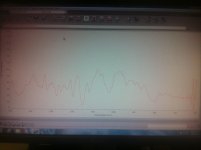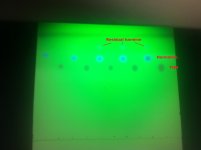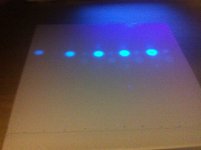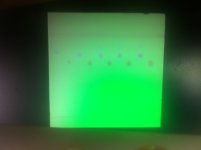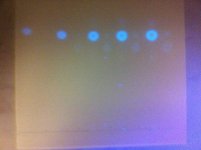None of those links have IR spectra for THH.
I honestly don't know that much about IR, my chemistry mentor is a toxicologist and master of the IR but she wasn't around today, so I had to ask another professor (a plastics chemist). My mentor had told me IR would be good for ID and to check the fingerprint region and see if it matches Shulgin's description, but I'm not too good at reading them and the other prof doesn't work with drug-like compounds so he wasn't much help. His advice was to find a picture of the spectra and compare.
Harmaline was obtained by making P harmala seed tea, A/B extraction several times w/ lab paper filtering, Manske salt precip x3, separation from harmine by careful pH manipulation (several times redissolved and pH slowly raised to wash out harmine), touched up with activated charcoal, and recrystallized from methanol/ethanol x2. Checked this with TLC, was mostly harmaline with a very faint (but real) dot of harmine at the top.
15g of this harmaline was put in a 250ml flask with some zinc (a couple of 'mossy' chunks and some powder), and ~150ml 3M Acetic Acid. Dropped in a stirbar and allowed to mix for the weekend 48+hr (occasionally adding more powdered zinc and extra 3M AcH when the bubbling slowed down). After the weekend, added concentrated NaOH which resulted in a bunch of clay-like white precipitate, which was filtered and air dried. This white clay was extracted 2x with dried IPA (91% store-bought, dried with MgSO4), which gave a deep brownish red color solution. This was filtered and concentrated in a distillation setup (to recover the IPA) to about 250ml, which was allowed to cool and then placed in the freezer. ~12hr later there was a precipitate of snow-white crystals (assumed to be THH), which were filtered out and washed with a little room-temperature IPA to remove the last of the reddish colored solvent. Yield was ~6g from ~15g (40%). I evaporated the rest of the reddish solvent to see if any more would come out, but when the solvent finished evaporating it was just some dark blackish-brownish-red goo.
I took half of it (3g), dissolved in warm IPA, added some concentrated HCl, and allowed to sit for a day (Shulgin's process for converting THH to THH HCl), and it behaved pretty much exactly how he described (sat around in solution doing nothing, even after being put in freezer a few times, then after 24hr just spontaneously dropped out all at once).
As for the IR spectra, at the advice of the plastics chemist, I took the background spectra of the air and whatnot, dissolved my sample in acetone, poured a little on the crystal plate and allowed it to dry directly on the surface, then ran the scan. The computer had recently been replaced and the printer wasnt set up yet, so I had to take pictures of the screen. I ignored most of the stuff in the higher range because both Shulgin and my mentor focus on the "fingerprint" region for ID, and the plastics chemist was pointing out groups not in the molecule (>2000 range), like "oh that is CO2 from me blowing on it, oh that's a small carbonyl bump possibly from acetone vapors still bouncing around." So my pictures are of the lower region. This is all I know.
IR is the only method of ID I have other than anecdotal stuff like the time it takes to dissolve/precipitate. All we have at my college is IR and a GC that I'm not allowed to use. The lab coordinator is very suspicious of me so I can't do much in the labs there unless I am with a prof, and my mentor is rarely there. I will be transferring to a proper university with well-equipped labs in the fall, but I would like to get a positive ID before then. I contacted a couple analytical labs but they have to buy reference samples of harmine, harmaline, THH, and anything else that might be in the mix, so their quotes were all like $1k+ to get a couple samples tested.
I attached the pictures I took of the IR reading, they are both of the same reading. One is the full spectrum that I just took a picture of part of. The other one I made the reading just from like 600-1500 range and took a pic of that. Same scan, just one is stretched out.
I know THH from Caapi shows up yellow on TLC plates while the synthed (racemic) shows up blue, but Shulgin says the IR spectra are the same for both, I just can't find an image of it. TIHKAL says "IR (in cm-1): 789, 804, 816, 838, 1033, 1160. "
Thanks again,
-Treehouse


